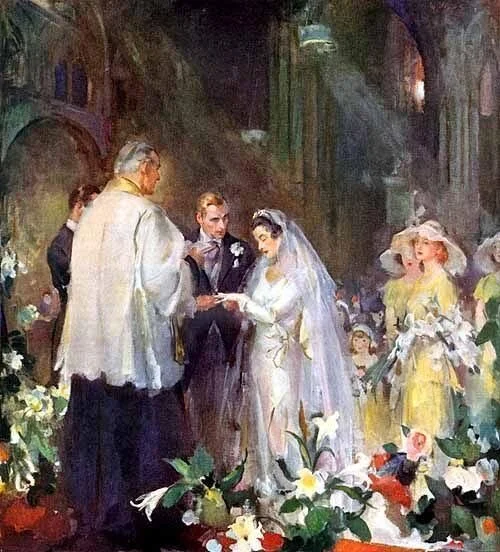The Sacrament of Marriage - a Brief Historical Overview – Part V
Legal form of marriage introduced by the Council of Trent
In the 10th / 11th century the situation evolved so that the Church assumed practically all jurisdiction over all matters relating to marriage. However, the Church has never tried to establish an official form of marriage that is compulsory for all. Some relationships, such as clandestine marriages, were punished very severely, but these marriages were valid. Over time, however, “the plague” of clandestine marriages, together with the great number of obstacles to marriage, has created great legal uncertainty. Therefore, in order to establish some clear legal norms for the validity of a marriage, the Fathers of the Council of Trent felt obliged to react. Although there were many doubts and discussions on this subject, the ecclesiastical legal form necessary for marriage was finally approved. This form was mandatory for the validity of marriage. Hence, a marriage between baptized persons was not valid if it was not contracted in the presence of a parish priest or another priest delegated by him and in the presence of at least two witnesses. Marriage should also be recorded in the church book kept for this purpose. The presence of the priest is purely passive; the priest is only a qualified witness. That is why his presence is enough, even if he did not consent to the marriage. Passive, accidental, or even forced presence is sufficient. The Council Fathers also decided that this form would be valid only in those territories where the conciliar documents would be officially promulgated. Hence, throughout the Church, after the Council, there was a double practice. Where these norms were promulgated, the canonical form of marriage was compulsory, but where this was not done, the previous customs and norms prevailed. So, this situation was not clear cut. Therefore, the decree of Ne Temere from August 2, 1907, gives new dispositions in this matter. According to this decree, the canonical form is obligatory for the whole Church and for all Catholics, even when they enter into mixed marriages. In order to put an end to new abuses, such as an unexpected marriage, it also requires the active presence of a priest: he must take an active part in the ceremony and must ask for mutual consent from the engaged couples.
Post- Council of Trent reflection on marriage
After the Council of Trent, we can observe, on the one hand, the final development of the concepts of systematic theology (canon studies had a great influence here), and, on the other hand, a certain decadence in the way of explaining the matrimonial reality and its sacramentality. Theologians discussed a long time to clearly explain the relationship between marriage as mutual consent and as a sacrament.
From the time the theory arose about when marriage happen (consent - 12th century) up to the 16th century, it was widely believed that the marriage contract and the sacrament of marriage identify with each other. But from the middle of the 16th century, this subject begins to be discussed. One of the first in this respect was Melchior Cano (1509–1560). According to him, contract and sacrament do not completely identify in marriage. The contract is the matter of the sacrament and the form is the priestly blessing. According to him, the ordinary minister of the sacrament is the priest and not the bride and groom. This theory has been transformed and used since the 17th century, especially in regal circles wishing to restrict the Church's laws on marriage in favor of royal power. For Melchior Cano, the matter of the sacrament was the natural contract between a man and a woman; the regalists, on the other hand, argued that the matter was a civil contract. This theory opened the way to create a civil marriage.
Today the same idea returns, although the reasons are different. For some time, some theologians have denied the unity of the marriage contract and the sacramentality by referring to the personal faith of the married. According to them, a distinction must be made between marriage as a natural contract, and this would be for those who do not believe although they have been baptized, and marriage as a sacrament for true believers.
These ideas, their practical consequences and the profound social transformation of the last two centuries are the cause of the progressive secularization of the marital reality. By denying any spiritual dimension to marriage, we can observe a deeper erosion of marriage and family life. Therefore, it is imperative to recover the original vision of marriage; marriage is always a sacrament among the baptized.
The spouses themselves are the ministers of this sacrament, and their union creates a new center of life, a new social cell. Sacramental marriage can be entered into by a man and a woman, baptized, free, who freely express their will to join before God and people. "To be free" in this case means not to be subjected to compulsion and not to be hindered by natural law (e.g., too closely related kinship) or ecclesiastical law (e.g., previously ordained priests or professed religious vows).
The Council of Trent (1545-1563) introduced the binding formula of marriage before the parish priest and two witnesses by a special decree. The present rites of the marriage sacrament recommend that "marriage between two Catholic believers should normally be celebrated at Holy Mass" (Vatican Council II, Sacrosanctum Conciliium, n. 61). In this way, the spouses seal their consent to mutual self-giving by uniting themselves to the sacrifice of Jesus and receiving the Eucharist, so that at the altar they may "form one body in Christ".
The matter of the sacrament of marriage is the mutual consent to the union by which the spouses give each other and accept: "I take you for my wife" - "I take you for my husband". The consent that binds the spouses is completed in that the two "become one flesh". No human authority can replace this consent, which should be an act of the will of each party, free from any compulsion and heavy external fear. If this freedom is not present, the marriage is invalid.
The purpose and meaning of marriage is deeply symbolized by the wedding ring. It is round and closed in on itself, which indicates the permanence and indissolubility of a marriage that, although it has a beginning, has no end, until death separates the spouses. It is made of gold, a precious and durable metal, which indicates the dignity and duty of faithfulness in conjugal love, which is to last like pure gold. The exchange of wedding rings between the newlyweds, when he puts on her wedding ring and she on him, indicates that they are giving themselves to each other with all they are and all they have.
The institution of marriage, on the foundation of which the family is created, the fundamental cell of social life, continues to be of particular concern to both the political community (the state) and the religious community (the Church). The basic expression of this concern is legislation, both state and church, where marriage and family law find its proper place. While in state legal systems we find norms coming exclusively from the legislature, the ecclesiastical (canonical) also includes legal system, and above all, norms coming from divine law. After all, the Second Vatican Council recalled that "a deep community of conjugal life and love" was "established by the Creator and regulated by His laws” (Gaudium et Spes, n. 48.)
Until Tomorrow
fr. george


